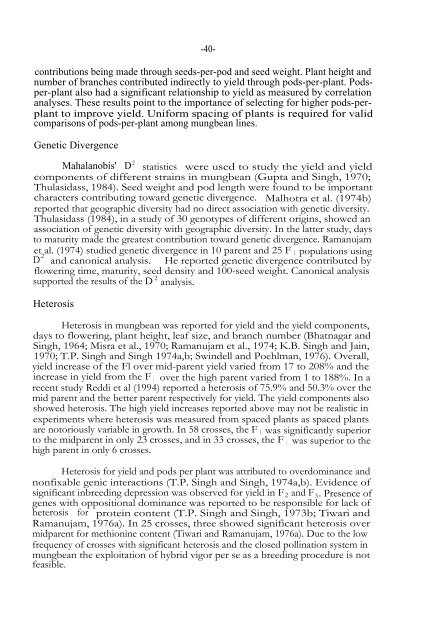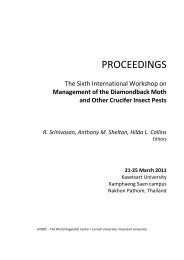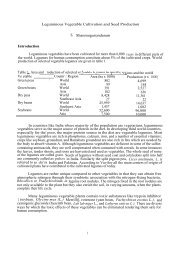MUNGBEAN VARIETAL IMPROVEMENT S. Shanmugasundaram
MUNGBEAN VARIETAL IMPROVEMENT S. Shanmugasundaram
MUNGBEAN VARIETAL IMPROVEMENT S. Shanmugasundaram
Create successful ePaper yourself
Turn your PDF publications into a flip-book with our unique Google optimized e-Paper software.
-40-<br />
contributions being made through seeds-per-pod and seed weight. Plant height and<br />
number of branches contributed indirectly to yield through pods-per-plant. Podsper-plant<br />
also had a significant relationship to yield as measured by correlation<br />
analyses. These results point to the importance of selecting for higher pods-perplant<br />
to improve yield. Uniform spacing of plants is required for valid<br />
comparisons of pods-per-plant among mungbean lines.<br />
Genetic Divergence<br />
Mahalanobis' D 2 statistics were used to study the yield and yield<br />
components of different strains in mungbean (Gupta and Singh, 1970;<br />
Thulasidass, 1984). Seed weight and pod length were found to be important<br />
characters contributing toward genetic divergence. Malhotra et al. (1974b)<br />
reported that geographic diversity had no direct association with genetic diversity.<br />
Thulasidass (1984), in a study of 30 genotypes of different origins, showed an<br />
association of genetic diversity with geographic diversity. In the latter study, days<br />
to maturity made the greatest contribution toward genetic divergence. Ramanujam<br />
et al. (1974) studied genetic divergence in 10 parent and 25 F 1 populations using<br />
D 2 and canonical analysis. He reported genetic divergence contributed by<br />
flowering time, maturity, seed density and 100-seed weight. Canonical analysis<br />
supported the results of the D 2 analysis.<br />
Heterosis<br />
Heterosis in mungbean was reported for yield and the yield components,<br />
days to flowering, plant height, leaf size, and branch number (Bhatnagar and<br />
Singh, 1964; Misra et al., 1970; Ramanujam et al., 1974; K.B. Singh and Jain,<br />
1970; T.P. Singh and Singh 1974a,b; Swindell and Poehlman, 1976). Overall,<br />
yield increase of the Fl over mid-parent yield varied from 17 to 208% and the<br />
increase in yield from the F 1 over the high parent varied from 1 to 188%. In a<br />
recent study Reddi et al (1994) reported a heterosis of 75.9% and 50.3% over the<br />
mid parent and the better parent respectively for yield. The yield components also<br />
showed heterosis. The high yield increases reported above may not be realistic in<br />
experiments where heterosis was measured from spaced plants as spaced plants<br />
are notoriously variable in growth. In 58 crosses, the F 1 was significantly superior<br />
to the midparent in only 23 crosses, and in 33 crosses, the F 1 was superior to the<br />
high parent in only 6 crosses.<br />
Heterosis for yield and pods per plant was attributed to overdominance and<br />
nonfixable genic interactions (T.P. Singh and Singh, 1974a,b). Evidence of<br />
significant inbreeding depression was observed for yield in F 2 and F 3 . Presence of<br />
genes with oppositional dominance was reported to be responsible for lack of<br />
heterosis for protein content (T.P. Singh and Singh, 1973b; Tiwari and<br />
Ramanujam, 1976a). In 25 crosses, three showed significant heterosis over<br />
midparent for methionine content (Tiwari and Ramanujam, 1976a). Due to the low<br />
frequency of crosses with significant heterosis and the closed pollination system in<br />
mungbean the exploitation of hybrid vigor per se as a breeding procedure is not<br />
feasible.

















